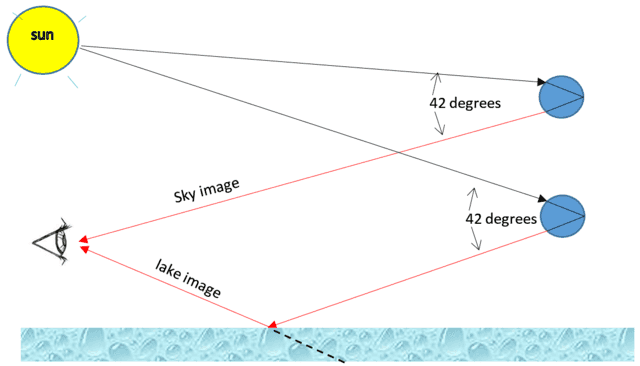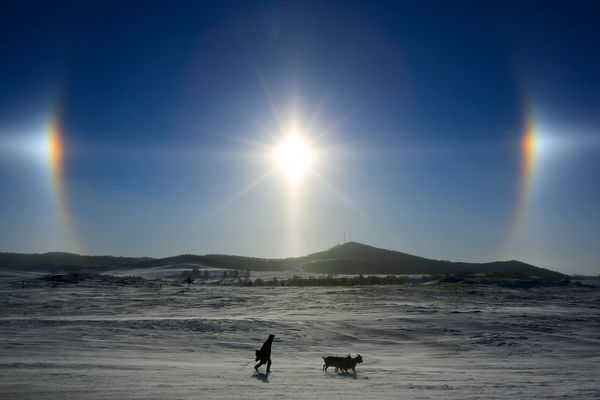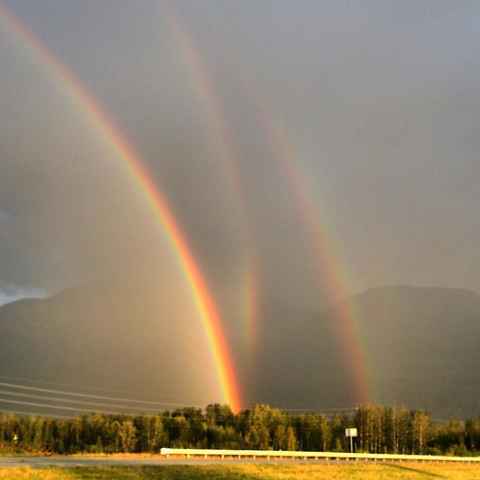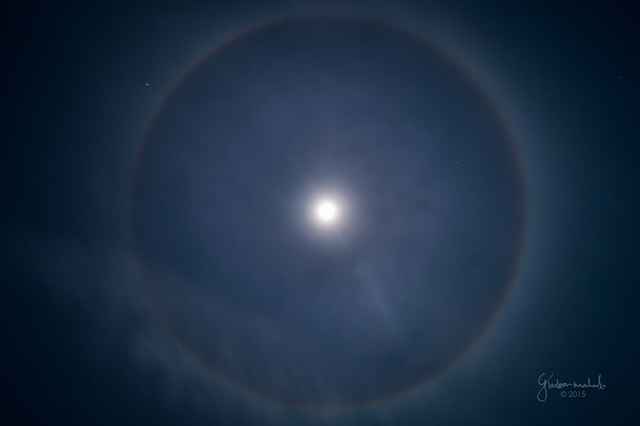Exploration into the Physics of Rainbows
For several years, I have been contemplating this beautiful picture by photographer Brian McPhee. I have a personal interest in the photograph because that boat is my year-round home. I also have a scientific interest in the photograph because of what it teaches me about rainbow physics.
The simplest explanation of rainbow physics is based on internal reflections in the near-spherical shape of a raindrop.
Light rays enter a raindrop from one direction (typically a straight line from the sun), reflect off the back of the raindrop, and fan out as they leave the raindrop. The light leaving the rainbow is spread over a wide-angle, with a maximum intensity at the angles 40.89–42°. (Note: Between 2 and 100% of the light is reflected at each of the three surfaces encountered, depending on the angle of incidence. This diagram only shows the paths relevant to the rainbow.) — See Wikipedia Rainbow or The Theory of the Rainbow (Scientific American 1977)


Look carefully at the photo of the boat. You will see that the sky inside the arc is much brighter than the sky outside the arc. Some scientists claim that no such effect exists, but it’s pretty plain in the picture. The explanation is that raindrops inside the arc reflect sunlight toward me, while drops outside the arc reflect sunlight away from me. The colors appear in the transition region where only certain colors are reflected towards my eye.
More challenging physics comes from the image of the rainbow seen on the surface of the water. At first, I assumed that it was a reflection of the rainbow in the sky, just like reflections of blue sky and white clouds one sees on a calm day in a reflecting pool. But then I came across Can Rainbows Cast Reflections? on the website of noted astronomer Bob Berman. Paraphrasing Berman. “No, they do not. Rainbows are not 3D objects and they do not cast reflections. In the water, you see a different rainbow, not a reflection.” I spent a lot of time puzzling over that because I didn’t understand Berman’s explanation. I also doubted its truth because I’m sure that I have seen rainbows in the rearview mirror as I drive. It sounds like the Hollywood version of vampires that don’t make reflections in mirrors.

At first, I thought that Berman meant that the image in the water was sunlight hitting the surface and creating a rainbow effect as it was refracted back to my eye. But no, that won’t work because the water in the lake is not in the form of spherical droplets.
After much thinking, I think I’ve got it. No vampire magic is required. The colored light you see from a rainbow is not omnidirectional, it is a unidirectional beam aimed at your eye. By analogy, imagine a man at the far end of a hall of mirrors holding a laser pointer pointed at your eye (assume a laser suitably attenuated for safety). The mirrors on the walls, ceiling, and floor of this hall will show many images of the man, but they will not show the red dot of the laser because the laser beam doesn’t hit those mirrors. However, if you turn your back, step to the side, and hold up a rearview mirror, you’ll see both the man and the red dot. That is because the rearview mirror is inside the cone of light from the laser pointer. So, to say that the red dot (or the rainbow) does reflect and that it does not reflect are both true statements depending on which mirror it refers to. Yet, the image of the man appears in all the mirrors. The man is a 3D object, but the red dot is not.
So, what do we see on the surface of the lake in the picture? That image is below the horizon from the eye of the camera. It is reflected light. It does pass through raindrops first, but not the same raindrops as the ones creating the sky image.
This diagram illustrates, [except for the important fact that light rays from the sun are parallel]. The image seen in the sky comes from different raindrops than the image seen reflected in the lake. The reflected image appears to be below the horizon (dotted line). In that sense, indeed, the image seen on the lake’s surface is not a reflection of the rainbow seen in the sky. It is a reflection of a different rainbow.
Using the same logic, it is correct to say that nobody else can see the same rainbow that I do. As I stand, a person sitting near me sees light reflected from different raindrops than I do. And if we consider light reaching him from the same raindrop, I might see green light while he sees red. That is because of the difference in angles between the drop, my eye, and his eye. In that sense, his rainbow is not the same as mine.
I was going to end this article here, but PF mentor jedishrfu urged me to continue with other rainbow effects, so I will. One of Wikipedia’s very best articles, Rainbow, is a rich source.
Table of Contents
Double, Triple, Quadruple, and Quintuple Rainbows
The primary rainbow is reflected once inside the raindrop. It is possible to have 2, 3, 4, or 5 reflections before the beam exits the drop. Of course, higher-order rainbows are dimmer and thus harder to see. (Picture source Tuscon News Now.)
Most of you have probably seen a double rainbow in real life. People living close to the Arctic Circle have probably seen triple rainbows.
If you see higher-order rainbows, they are always outside and concentric from the primary rainbow. If the order of colors in the odd-numbered rainbows is ROYGBIV, then the order in the even-numbered rainbows is VIBGYOR.
Twinned Rainbow
Let me make an assertion. To see a rainbow, many or most of the raindrops must be of uniform size and shape. My argument for that is that drop size and shape are related. As the drops fall, air resistance flattens small drops more than large drops. Flattened drops reflect at a different angle. Flattened drops might also oscillate or tumble. If the statistics of the raindrops are diverse, then the light will be reflected in many directions other than toward your eye, so you won’t see a rainbow. If you do see a rainbow, that is direct evidence of the uniformity or correlation of the drop statistics.
A twinned rainbow happens when there are two predominant drop sizes. The small flattened drops reflect at a different angle than the larger drops.
Circular Rainbows
A rainbow is usually seen as less than half a circle. In the right circumstances, full-circle rainbows can be seen above you in the sky, or below when you view from high up. However, physics is the
same.
Contrary to my prior beliefs, I learned that full-circle rainbows are not the same physics as a glory or a 22° halo.
Wikipedia says that the glory is believed to happen due to classical wave tunneling, when light nearby a droplet tunnels through the air inside the droplet and are emitted backward due to resonance effects. (Picture Brocken Inaglory)

The 22° halo is due to reflections in ice crystals that are hexagonal, not spherical. (Picture Gladson Machado)
Sun dogs are closely related. The image below shows very bright sun dogs in Fargo, North Dakota. Also visible are parts of the 22° halo (the arcs passing through each sundog), a sun pillar (the vertical line), and the parhelic circle (the horizontal line).


Supernumerary Rainbow
A supernumerary rainbow—also known as a stacker rainbow—is an infrequent phenomenon, consisting of several faint rainbows on the inner side of the primary rainbow, and very rarely also outside the secondary rainbow. Supernumerary rainbows are slightly detached and have pastel color bands that do not fit the usual pattern.
It is not possible to explain their existence using classical geometric optics. The alternating faint rainbows are caused by interference between rays of light following slightly different paths with slightly varying lengths within the raindrops.
The very existence of supernumerary rainbows was historically the first indication of the wave nature of light, and the first explanation was provided by Thomas Young in 1804 — Wikipedia Rainbow
A supernumerary rainbow picture by Andrew Dunn
Reflected and Reflection Rainbows
The picture of the boat shows a reflected rainbow. We already discussed the physics of that.
A reflection rainbow is seen when the sunlight is reflected from the water surface first, then up to raindrops in the sky, then internally reflected by raindrops back toward your eye.
Monochrome Rainbows
When the sunlight is red, such as at dawn or dusk, then rainbows can still be formed but they will be monochrome. (Image by www.rodjonesphotography.co.uk)
When rainbows are formed by moonlight, they appear to be the
same white color as The Moon. Fogbows also appear to be mostly monochromatic. Fogbows are formed by the same physics as rainbows, but they are made with much smaller drops closer to the horizon.
Someday (probably well beyond my lifetime) we could have a close passage by a large comet with a brilliant tail. If that happens, rainbows could be formed with comet light. They would show us the spectrum of the comet’s light source, monochromatic or not.
Could we see a rainbow formed by the light from an aurora in the stratosphere? That sounds difficult (because the aurora is not a point source) but not quite impossible. That is fun speculation. Maybe someone could finance a year for me in Iceland so that I could research that.
Mystery Rainbow
This remarkable picture, by dabrandner, appears to show a
third rainbow sandwiched between the primary and secondary double rainbows. I call it a mystery because I’m not sure if the third rainbow is a twinned rainbow or a reflection rainbow, or some other kind. [Reader comments are welcome.]

Conclusions
I confess that when I started this article with just a picture of my boat, I had no idea how far my research would take me into interesting physics phenomena. Thank you jedishrfu for egging me on.
Using the sky as a scientific instrument, we can observe:
- How light behaves inside the raindrops.
- The reflection behavior of unidirectional versus omnidirectional light beams.
- The statistical distribution of drop size and shape.
- Some quantum effects (Superluminary)
- Evanescent wave coupling, is an exotic field of optics I never heard of before.
- A spectrograph of the light source.
- Science History from 1804.
I’m sure you will agree, that is very cool.
Thanks to jedishrfu and to Greg Bernhardt for their assistance and encouragement.
Dick Mills is a retired analytical power engineer. Power plant training simulators, power system analysis software, fault-tree analysis, nuclear fuel management, process optimization, power grid operations, and the integration of energy markets into operation software, were his fields. All those things were analytical. None of them were hands-on.
Dick has also been an exterminator, a fire fighter, an airplane and glider pilot, a carney, and an active toastmaster.
During the years 2005-2017. Dick lived and cruised full-time aboard the sailing vessel Tarwathie (see my avatar picture). That was very hands on. During that time, Dick became a student of Leonard Susskind and a physics buff. Dick’s blog (no longer active) is at dickandlibby.blogspot.com, there are more than 2700 articles on that blog relating the the cruising life.












Rainbow with spokes:
[IMG]http://cuug.ab.ca/kmcclary/RAINBOW_RAYS.png [/IMG]
Snapped from moving car in BC, Canada .
Explanation of a very similar image [URL=’http://epod.usra.edu/blog/2008/12/yarra-valley-rainbow-wheel.html’]here[/URL] .
“but on PF gravity waves usually mean something else.”
I was confused when I first read the term in a non-GR context. All it means is a surface wave on a fluid (often water) where the restoring force ( to make the water level) is gravity – just plain old waves. They can happen at the interface between any two fluids, aamof. I think it’s what you can see when you look from a mountain top at a layer of cloud, below you (when there’s no detectable wind) and the cloud layer seems to form slow motion waves which appear to ‘crash’ on the mountain slope. Good excuse to stop climbing and just enjoy it.
Here’s another something that vaguely resembles a rainbow. At least it is bow shaped with the roughly 42 degree bow size, but the explanation is very different.
[IMG]http://apod.nasa.gov/apod/image/1601/AirglowFan_Lane_2400.jpg[/IMG]
Image Credit & Copyright: [EMAIL=’ david dot lane07 at gmail dot com’]Dave Lane[/EMAIL]; Rollover Annotation: [URL=’http://geckzilla.com/’]Judy Schmidt[/URL]
[URL]http://apod.nasa.gov/apod/ap160127.html[/URL]
[QUOTE=APOD]Explanation: Why would the sky look like a giant fan? [URL=’http://www.atoptics.co.uk/highsky/airglow1.htm’]Airglow[/URL]. The featured intermittent [URL=’https://www.youtube.com/watch?v=te_H0Uo6YEA’]green glow[/URL] appeared to rise from a lake through the arch of our [URL=’http://www.atlasoftheuniverse.com/galaxy.html’]Milky Way Galaxy[/URL], as captured last summer next to [URL=’https://www.youtube.com/watch?v=q8eQKvlSb9Q’]Bryce Canyon[/URL] in [URL=’https://en.wikipedia.org/wiki/Utah’]Utah[/URL], USA. The unusual [URL=’http://apod.nasa.gov/apod/ap160127.html’]pattern was created by[/URL] atmospheric [URL=’http://www.nasa.gov/multimedia/imagegallery/image_feature_484.html’]gravity waves[/URL], ripples of alternating air pressure that can grow with height as the air thins, in this case about [URL=’http://earthobservatory.nasa.gov/NaturalHazards/view.php?id=79817′]90 kilometers up[/URL]. Unlike [URL=’http://apod.nasa.gov/apod/ap140714.html’]auroras[/URL] powered by collisions with energetic charged particles and seen at high latitudes, airglow is due to [URL=’http://www.atoptics.co.uk/highsky/airglow2.htm’]chemiluminescence[/URL], the [URL=’http://apod.nasa.gov/apod/ap130619.html’]production of light[/URL] in a chemical reaction. More typically seen near the horizon, [URL=’http://en.wikipedia.org/wiki/Airglow’]airglow[/URL] keeps the night sky from ever being completely dark.”
That’s interesting, but on PF gravity waves usually mean something else. The explanation also does not explain why it is bow shaped.
Has anyone else noticed that the peephole lens in their front door
[ATTACH=full]95011[/ATTACH]
makes rain-bowish spots, on the chimney of their wood stove?
[ATTACH=full]95012[/ATTACH]
“Wow! It gets more and more interesting. Bows in salt water. Bows in glass. It makes me wonder what other mists, what other solids, can make bows.”
Rain made of diamond droplets could not make a primary rainbow. Only higher bows, because of the high index of refraction. [[URL=’http://www.askamathematician.com/2011/05/q-if-you-suddenly-replaced-all-water-drops-in-the-sky-with-same-sized-spheres-of-polished-diamond-what-would-happen-to-the-rainbow/’]1[/URL]]
“I wonder how a physicist can struggle so much with such an incredibly simple phenomenon as rainbows.”
It’s refreshing to read of someone who finds the topic so straightforward. I hope your confidence is well founded.
“[URL]http://www.atoptics.co.uk/rainbows/seabow.htm[/URL]”
Wow! It gets more and more interesting. Bows in salt water. Bows in glass. It makes me wonder what other mists, what other solids, can make bows.
Thanks for sharing.
“[IMG]https://img.washingtonpost.com/blogs/capital-weather-gang/files/2015/04/CDHE0hUVEAAYA56.jpg[/IMG]
This picture is reported to have gone viral today, from Glen Cove, NY.
…[/quote]
Does it mean I’m obsessed with rainbows, if I admit that I recognize this one?
[URL=’https://www.physicsforums.com/threads/what-caused-the-quadruple-rainbow.809896/’][U]What caused the Quadruple Rainbow? [/U][/URL][PF]
21 April, 2015
I think it’s true what Walter Lewin said in the last two minutes of his “The Hidden Beauty of Rainbows” lecture, regarding a new fascination, once you know how they work. (Or at least, think you know how they work.)
[INDENT]”This is like a disease
You can’t resist it
And it’s all my fault
I cannot cure you any more
It’s too late for that
It is a disease for life”
[INDENT]— Walter Lewin[/INDENT][/INDENT]
“Most people would say that it is four rainbows, but since there is only one virtual image at infinity, others would argue that it is only one.”
I do not think anyone would argue that. The one image at infinity is predicated on there being one point source of light at infinity, which is not always the case. Optical effects may lead to several images (as in the later photos) being reflected by the raindrops.
On a side note, I saw sun dogs for the first time (at least as far as I have noticed) just about a year ago. I was amazed at how strong they can actually become.
“Most people would say that it is four rainbows, but since there is only one virtual image at infinity,[COLOR=#ff0000] others would argue that it is only one[/COLOR].”
I refuse to be drawn in on this one!!! :wink: All those pictures are very pretty, though. I wish I could have been there.
[IMG]https://img.washingtonpost.com/blogs/capital-weather-gang/files/2015/04/CDHE0hUVEAAYA56.jpg[/IMG]
This picture is reported to have gone viral today, from Glen Cove, NY. Most people would say that it is four rainbows, but since there is only one virtual image at infinity, others would argue that it is only one.
Edit: Also from today’s news [URL]https://www.washingtonpost.com/news/capital-weather-gang/wp/2015/01/12/nine-optical-phenomena-captured-in-one-amazing-photo/[/URL]
[IMG]https://img.washingtonpost.com/wp-apps/imrs.php?src=https://img.washingtonpost.com/blogs/capital-weather-gang/files/2015/01/B7AQwC8CEAA-BjY.jpg&w=1484[/IMG]
[IMG]https://img.washingtonpost.com/wp-apps/imrs.php?src=https://img.washingtonpost.com/blogs/capital-weather-gang/files/2015/01/B7E5k9MCQAIqzme.jpg&w=1484[/IMG]
“Does the focus of the camera affect how sharp natural rainbows appear in the picture?”
This has been worrying me. The raindrops can be, indivudually, very small (<1mm) and diffraction could be relevant but I can't be sure of the appropriate calculation, bearing in mind the enormous range of distances involved - between a couple of metres and a km. The diffraction limit for a 1mm aperture at 600nm is about 6 e-6 (in radians). How this could relate to the effect on focussing the line (arc), I can't be sure. Also, as Walther Lewis says in his lecture 'Rainbows and Blue Skies' in the above post that there is a 'narrow peak' in the range of angles which are wavelength selective. He makes the point that the region where the bow occurs is the only place where the wavelengths are individually selected. The sharpness of an arc will depend on how narrow this peak happens to be.
If anyone has access to a laser and a hose, they could do an experiment for us and tell us (or use a camera to show us) the sharpness of the arc and the effect of focussing at different distances.
“…I don’t know how illuminating they are towards the discussion, but they interesting to look at.
…[/quote]
As long as they are inspirational, they are illuminating.
I just watched Walter Lewin’s “[URL=’https://www.youtube.com/watch?v=eDByEKf2IEM’][U]Rainbows and Blue Skies[/U][/URL]” for the third freakin’ time, and his “[URL=’https://www.youtube.com/watch?v=iKUSWJWMSk4′][U]The Hidden Beauty of Rainbows[/U][/URL]” for at least the second, because of your images.
I also reread the insight article. It was better the 4th time around.
I will have to read the comments again, after my nap, as I still don’t know where the rainbow is. :oldwink:
[quote]One thing I should mention is that these are not perfectly accurate physical representations. One limitation is that once the white light is broken up in to its spectra, the refractive index for each color does not vary. In reality, each color would refract slightly differently. For instance, in the POV-ray model after passing light through a prism, passing it through a second prism will not reassemble the spectrum back into white light.”
Mere technical difficulties.
Have you ever started, or been involved in a ray-tracing thread?
I worked out, mentally, how to optimize them, decades ago.
Unfortunately, life got in the way, and disrupted implementation.
Kind of like, naps…. :sleep::sleep::sleep: